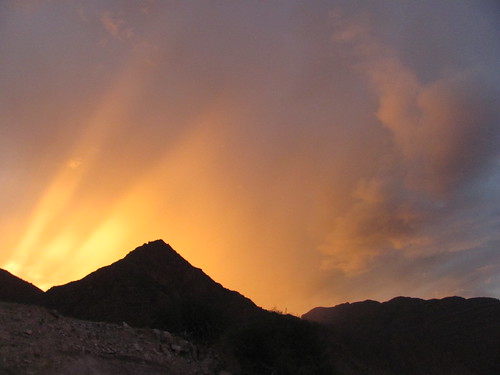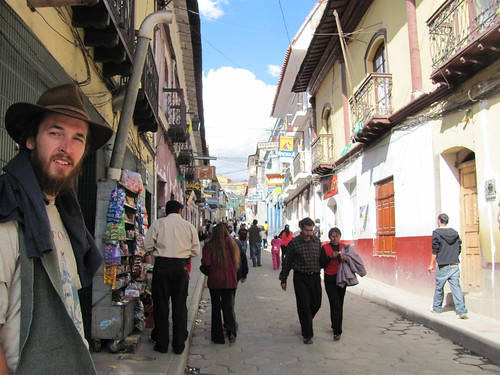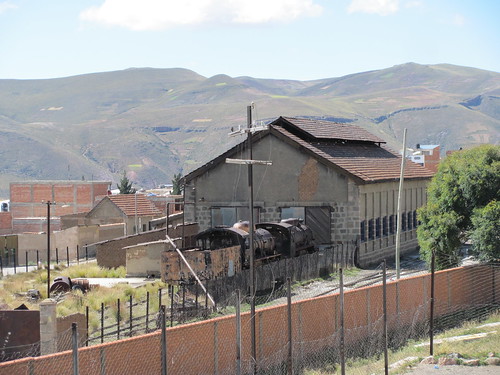 We climbed this road. Far in the distance you can see Tarija and the Lago San Jacinto, Bolivia
We climbed this road. Far in the distance you can see Tarija and the Lago San Jacinto, Bolivia A view from the first day. We were happy that we didn´t have to climb this road. There are unfortunately no photos of the crazy switchbacks up to the very top but one might picture something in between these two.
A view from the first day. We were happy that we didn´t have to climb this road. There are unfortunately no photos of the crazy switchbacks up to the very top but one might picture something in between these two. The drivers left us in El Puente and we stood in the shade eating ice cream cones, a bit dazed back in the lower, hot country. After 10 minutes we were invited in to rest with the Familia Tapia, blowing up balloons for the Añera that evening. The first birthday is the biggest in Bolivia, and we were invited. Of course then they were getting out the clown clothes and Chris and Courtney were drawing straws. Chris chickened out and Courtney put on the payazo suit and red nose.
By 8pm, the kids had eaten 3 courses of sweets and were sent home. The adults brought out the coca leaves and lemony singani drink, which is served family style out of a pitcher into one rotating glass. For dinner we had fricase, which is big boiled corn kernels, with potatoes, pork, and oily sauce. And then of course we watched some of the people make faces as they sipped their wine before mixing it with coca-cola or fanta. We went to bed while they had a dance party.
In the morning they were opening the presents and drinking beer, passing one glass around the room. They asked us to stay longer, then they asked us to come back one day, then they said ¨you´re doing what? biking to Potosí?¨ Yes, you only asked 4 times.
We found the paved road about 10KM away and felt good, cycling in a beautiful rolling red canyon. We camped high over the river and saw a beautiful sunset behind the mountain. The next day the road continued, beautifully paved in cement. We arrived in Camargo and stocked up at the giant central market, and ate a big fresh lunch in the lush plaza. Again, we were approached and asked to stay, this time at the Parrochia, where one of the fathers is German and welcomes foreigners to stay. Of course, the people of the city were inviting us, so we had to ask at the church, where the people were not quite as friendly as in the street. It was very strange to sleep in separate dorm rooms.
It was good to stop in Camargo because the pavement ended on the way out of town, because the road started to climb. For one thing, we were told that in Southern Bolivia they don´t get any of the money, which all goes to La Paz for distribution, getting lost in the corrupt government. The way people describe the Evo Morales government is ¨less corruption.¨
So they don´t have much in the way of paved roads in the south. There are sections of pavement, usually leading into or away from a city, never both. And all the worst sections of road are unpaved, made of sand, gravel, small and large rocks, usually littered with rocks the size of a fist; these are the roads that climb in straight ragged lines up the sides of mountains. One theory we came up with is that they didn´t pave these sections because they intended to bring in the earth movers and actually build a planned, gently sloping route, but never got around to it.
We had set out from Camargo and hitch hiked for the second time, gaining about 30KM and a basket full of peaches on the way to a peach orchard. We lunched and set out again up a steep paved bit of road. Then down, a turn, and we looked up at a big mountain covered in switchbacks. We felt a few rain drops, then heard an enormous thunder crash from the top. High comedy, straight from cartoons, which come evidently straight from Bolivia. At the top of the mountain it started to rain and we found a grouping of 3 houses made of earth. Two were abandoned and we had found our dry campsite.
From that point on, our legs were slightly more used to the terrain and we wanted to make a bit more progress each day. But every time the road got a bit flat, or went downhill, it turned into a washboard, or was strewn with rocks the size of our heads. Then we started to get flat tires. Chris went too fast down one hill, hit a big rock, spilled over and took an arm full of little cuts. At the bottom of the hill Courtney´s tire and tube received a big gash, so we camped.
The next day we climbed up to a big flat section of pampa and saw another beautiful sunset. Only one flat tire that day. In the morning we each had an inexplicable flat, due to moderately paced leaks. Mid morning we stopped to re-inflate and a valve exploded, giving Chris the opportunity to try out a tube whose valve had broken at the base and been fixed with a mixture of shoe goo and jb weld. Amazing fix!
We were now feeling masochistic, stopping only to fix tubes and groaning slowly towards the asphalt we knew to be close. In the evening we achieved the asphalt and got a tire and tube fixed at the Gomeria, camped behind the gas station, and had tea before bed.
 Some kids that thought Chris was really cool as he fixed one of the many many flats we got along the way.
Some kids that thought Chris was really cool as he fixed one of the many many flats we got along the way. Our hearts were full of happiness, but our bodies were so exhausted we could barely keep our breakfast down. We climbed what we guess was 1000m over 35KM on the way into Potosí, before descending 500m into the city. The city is very pretty, with the ¨mountain made of silver¨ looming above.
Our day of rest here, Easter Sunday, and election day, has been beautiful and sunny. We took a walk and some Koreans, living here to build wells for the Bolivian govt, invited us in for coffee. ¨In Bolivia they have very fertile soil,¨ they said, ¨in Korea we don´t have good soil, so we study very hard.¨ They added that they don´t like Evo who they see as a dictator. When asked if they liked Bolivia, they replied ¨yes,¨ that they make a lot of money, and gave a classic hmm and haw to the question ¨what else do you like?¨ When we got back to our hostal, Chris layed in bed for a few hours while Courtney made him spicy soup to ease his sore throat.
What to do from here? Were going a short distance north to have another day of rest at Miraflores, a hot spring area.





next time you meet up with some Koreans, say "anyon-hosayo!" (this is phonetic, for your convenience)
ReplyDelete-Amanda